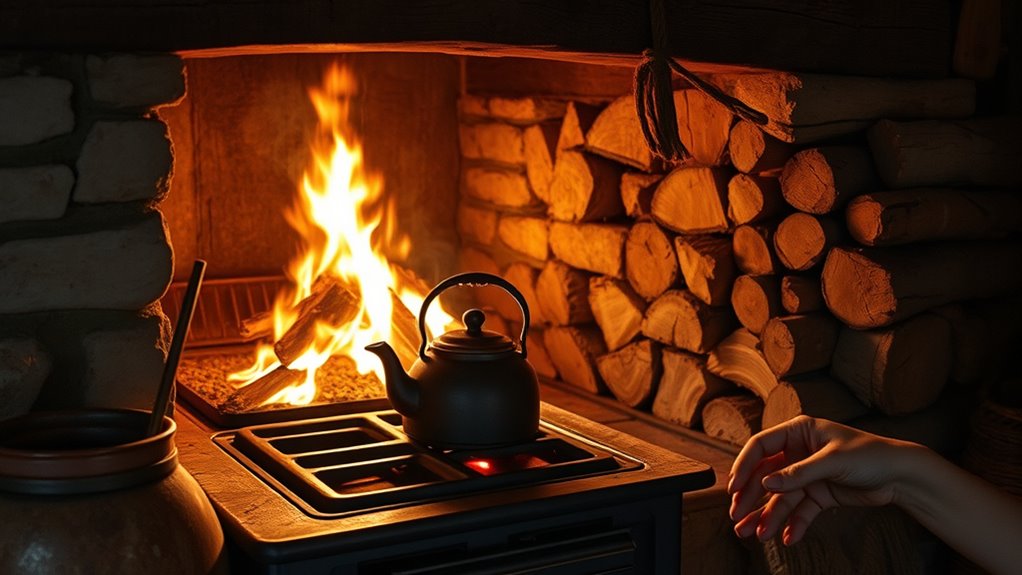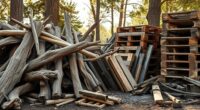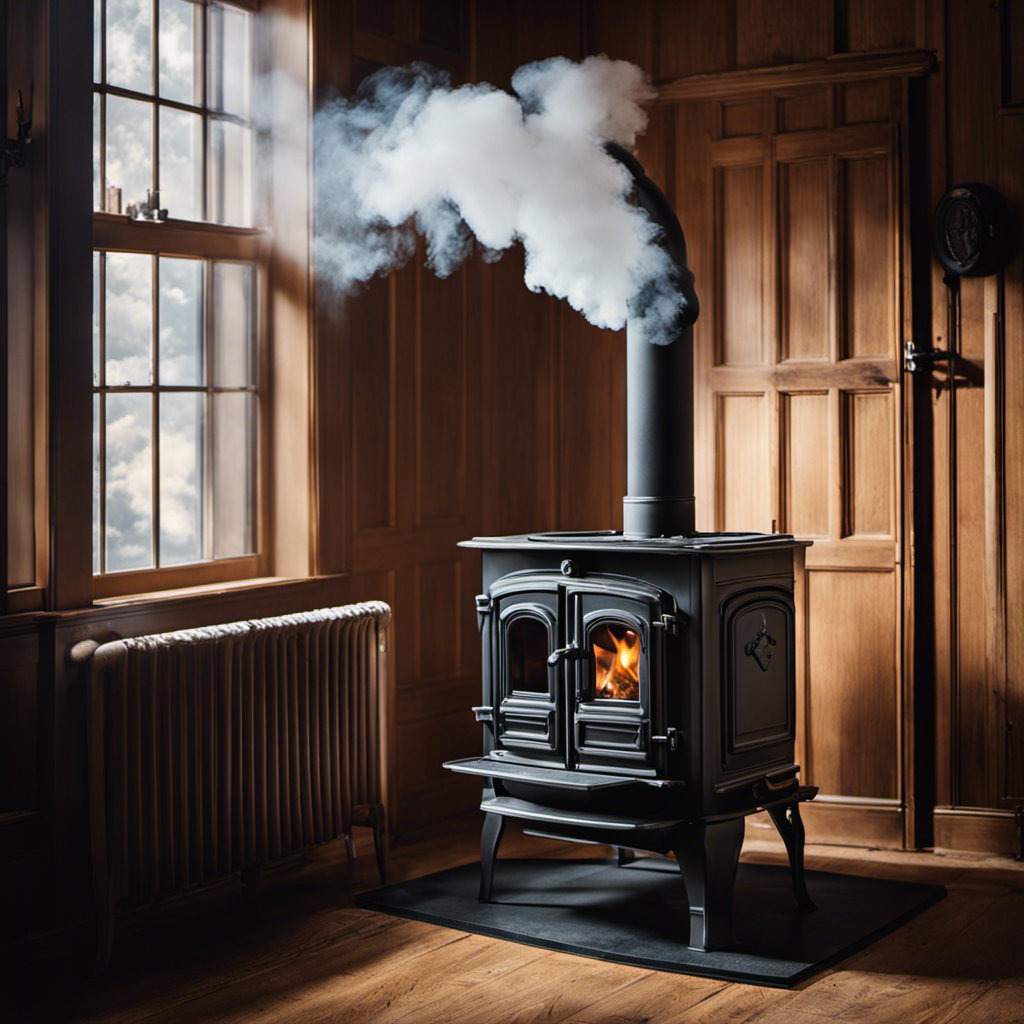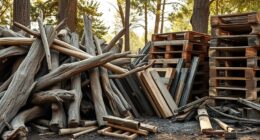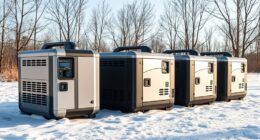To maintain an efficient and safe daily routine with your wood stove, start by gathering properly seasoned firewood and store it in a dry, ventilated area. Build a fire with kindling, newspaper, and larger logs, then keep it burning steadily by adding small, dry logs and adjusting vents. Regularly clean out excess ash and check for safety, ensuring your setup runs smoothly. If you want to know how to manage these steps daily, you’ll find useful tips ahead.
Key Takeaways
- Prepare and store dry, seasoned firewood in a well-ventilated, covered area for easy access and efficient burning.
- Build the fire with kindling and larger logs, ensuring proper airflow and ventilation for safe ignition.
- Maintain the fire by adding small, dry logs gradually and adjusting air vents for consistent heat output.
- Regularly remove excess ash and clean the interior to promote efficient combustion and prevent soot buildup.
- Perform routine safety checks, including chimney cleaning, detector function, and proper fire extinguisher placement.
Gathering and Preparing Firewood

Gathering and preparing firewood is a vital step to guarantee your wood stove operates efficiently and safely. Proper firewood storage keeps your wood dry and ready for use, preventing moisture that can hinder combustion. When it’s time to gather, focus on seasonal chopping to ensure your firewood is properly seasoned, which improves burning efficiency and reduces smoke. You should cut and split wood ahead of time, ideally several months before you need it, to allow it to dry thoroughly. Store the firewood in a well-ventilated, covered area that keeps it off the ground. This preparation not only makes lighting easier but also helps your stove burn cleaner and more efficiently, saving you time and effort during colder months. Additionally, choosing vetted firewood products can ensure you are using safe and reliable materials. Ensuring your firewood is properly sourced and prepared can also contribute to sustainable firewood practices, supporting environmentally friendly heating.
Building and Lighting the Fire
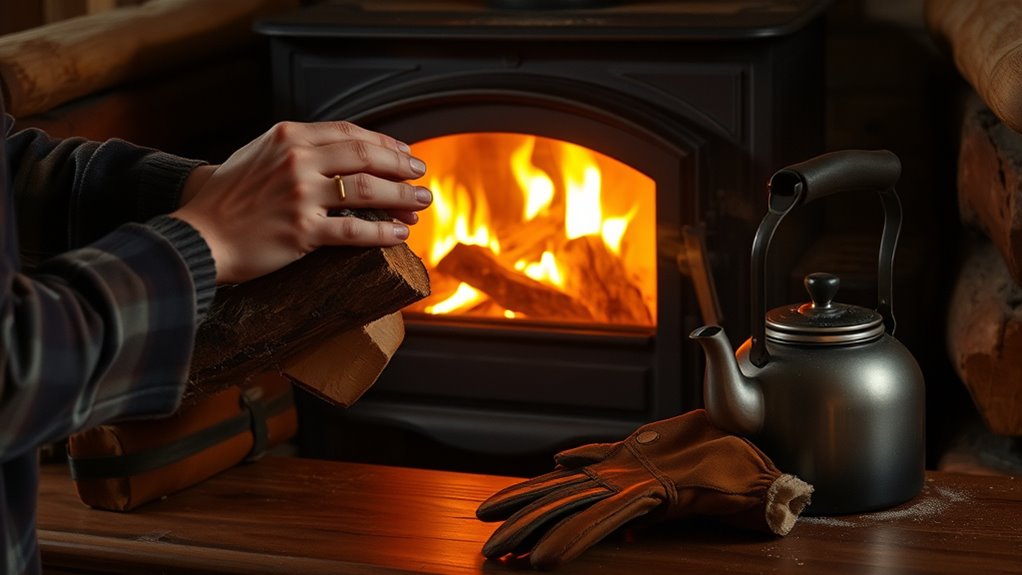
Once your firewood is properly seasoned and stored, it’s time to build and light the fire. Start by arranging your wood using smart wood storage solutions that keep logs dry and accessible. For an inviting look, consider integrating your firewood stack into your fireplace decor, creating a cozy aesthetic. Begin with a layer of crumpled newspaper or fire starters at the bottom, followed by small kindling arranged in a teepee shape. Place larger logs on top, leaving enough space for airflow. Light the fire starter and gently blow on the flames to encourage combustion. Ascertain the damper is open to allow smoke to escape. With a steady flame, your wood stove will soon provide consistent warmth and add charm to your home. Proper airflow management is essential for efficient burning and safe operation. Additionally, ensuring proper ventilation helps prevent smoke buildup and maintains indoor air quality. Incorporating properly seasoned wood enhances combustion efficiency and reduces smoke. Remember that selecting the right fireplace accessories can further enhance safety and convenience during your fireplace use. Being aware of emergency preparedness essentials can also help you handle unexpected situations that may arise during heating or in other emergency scenarios.
Maintaining the Fire Throughout the Day

To keep your fire burning steadily throughout the day, you need to make some simple adjustments and regular checks. Start by ensuring your firewood storage is organized, so you can easily access dry, seasoned wood. Use quality stove accessories like a poker or log lifter to safely adjust the logs without disturbing the fire too much. Keep an eye on the fire’s heat and add small, well-placed pieces of firewood when needed, avoiding overloading. Proper airflow is essential, so periodically check the air vents and adjust as necessary. Remember to keep the fire’s core stable by rearranging logs gently. Maintaining good airflow also helps prevent smoke buildup and ensures efficient burning. By maintaining these habits, your wood stove will burn efficiently, providing consistent warmth without constant tending.
- Organize firewood for easy access
- Use stove accessories for safe adjustments
- Add small, dry logs as needed
- Check and adjust air vents regularly
- Rearrange logs gently to sustain the fire
Managing Ash and Clean-up

Regularly managing ash and clean-up helps keep your wood stove functioning efficiently and safely. Remove excess ash using a metal scoop or ash shovel, and dispose of it in a metal container away from your home. Keeping ash levels low promotes better airflow and combustion. When performing stove cleaning, wipe down the interior with a damp cloth to remove soot and debris, preventing buildup that could hinder performance. Also, check the ash grate and vents for blockages. Regular ash disposal reduces fire risk and improves stove efficiency. Remember, never leave hot ashes unattended, and always allow them to cool completely before disposal. Consistent stove cleaning and ash management not only extend your stove’s lifespan but also ensure safe, effective heating.
Ensuring Safety and Efficiency

Ensuring safety and efficiency with your wood stove requires careful attention to proper operation and maintenance. Fire safety is vital; always keep combustibles away and install smoke and carbon monoxide detectors nearby. Regular stove maintenance helps prevent dangerous creosote buildup and guarantees peak performance. Additionally, understanding fire safety regulations can help inform safety precautions during holiday celebrations. Here are some tips:
Prioritize regular maintenance and safety measures to keep your wood stove running efficiently and securely.
- Perform annual chimney inspections and cleanings
- Check door seals and gaskets for leaks
- Use seasoned wood to reduce smoke and emissions
- Keep a fire extinguisher nearby
- Never leave a burning stove unattended for long periods
- Being aware of fire safety protocols can further enhance your safety measures during use. Incorporating remote monitoring technology can also provide an extra layer of security and peace of mind when managing your wood stove. Regularly inspecting your stove components and understanding proper operation techniques can contribute significantly to both safety and efficiency.
Frequently Asked Questions
How Do I Choose the Best Wood for My Stove?
When choosing the best wood for your stove, you should consider the types of firewood that burn efficiently, like hardwoods such as oak or maple. Avoid softwoods that produce more creosote. Store your wood properly with good ventilation and off the ground to keep it dry and ready to burn. This guarantees you get sustained heat and minimizes buildup, making your stove safer and more effective.
What Are Signs of a Dangerous or Inefficient Fire?
You should watch for signs of a dangerous or inefficient fire, like creosote buildup inside your chimney, which can cause chimney fires. Unusual odors coming from your stove or venting system might indicate incomplete combustion or dangerous fumes. If your fire burns unevenly or produces excessive smoke, it’s a sign to adjust your wood or check your stove’s settings. Regular inspections and proper maintenance keep your fire safe and efficient.
How Can I Improve Stove Efficiency During Cold Snaps?
To improve stove efficiency during cold snaps, focus on proper seasonal wood storage to guarantee your wood is dry and burns effectively. Use draft management techniques like sealing gaps and installing a door draft stopper to prevent heat loss. These steps help maintain consistent heat, reduce fuel consumption, and keep your stove running smoothly, so you stay warm even during the coldest weather.
What Should I Do if the Stove Backdrafts?
Did you know that backdrafts occur in nearly 15% of homes with wood stoves? If your stove backdrafts, you should immediately stop using it and open windows to improve ventilation. Use ventilation troubleshooting to identify blockages or leaks in your chimney or flue. Implement draft prevention techniques like installing a chimney cap or ensuring proper stove placement. These steps help keep your home safe and improve stove efficiency.
How Often Should I Inspect and Maintain My Stove?
You should inspect and maintain your stove regularly to guarantee safe operation. Check your chimney cleaning schedule at least once a year to prevent creosote buildup, and remove ash frequently to keep airflow unobstructed. Also, inspect for any cracks or damage. Doing these tasks keeps your stove efficient, safe, and prolongs its lifespan. Regular maintenance helps prevent issues like backdrafts and keeps your home warm and secure.
Conclusion
Living with a wood stove becomes second nature once you master the routine. As the saying goes, “A stitch in time saves nine,” staying attentive guarantees your fire stays safe and efficient. With regular gathering, building, maintaining, and cleaning, you’ll enjoy cozy warmth and a sense of accomplishment. Embrace the rhythm of your daily routine, and you’ll find that a well-tended fire brings comfort and peace to your home all winter long.

